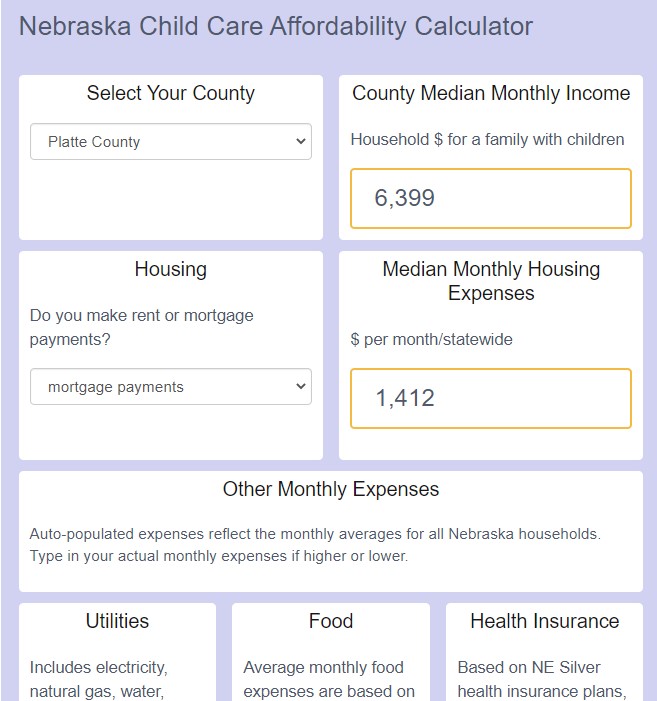 At First Five Nebraska, we are often asked, “What does the average Nebraska family pay for child care?” And as much as we’d like to give a single number, the truth is that the child care market is complex, and the price families pay for child care depends on several factors, including the area of the state where the child care program is located, the number of children needing care and their ages, and the type of provider. And of course, the price a family pays for child care also depends on how much their family budget can allot for the expense.
At First Five Nebraska, we are often asked, “What does the average Nebraska family pay for child care?” And as much as we’d like to give a single number, the truth is that the child care market is complex, and the price families pay for child care depends on several factors, including the area of the state where the child care program is located, the number of children needing care and their ages, and the type of provider. And of course, the price a family pays for child care also depends on how much their family budget can allot for the expense.
Knowing that this simple question has a complex answer, we partnered with the Committee for Economic Development of the Conference Board to develop a calculator that places the expense of child care within a family budget for Nebraskans.
The decisions families make about their children’s care and learning environments depend on the income they have available after basic needs are met. Even before factoring in child care, many families are stressed financially. It’s important for policymakers and employers to understand the effect child care expenses have on a family budget.
The Nebraska Child Care Affordability Calculator allows users to see how licensed child care may, or may not, fit into a typical family budget.
Uses county, statewide data
The Calculator begins with what we know about family incomes and expenses. The median income for families with children varies greatly across the state, so the calculator is designed to include income data from each of Nebraska’s 93 counties. Other common household expenses—rent/mortgage, utilities, food, health insurance and vehicle-related—vary less across the state, so statewide averages provide the baseline to calculate pre-child care net income (income minus common household expenses).
The Nebraska Child Care Affordability Calculator allows users to input information on the age and number of children needing care by region and type of licensed care a family prefers (family child care home or child care center).
We know it’s important to have choice in child care arrangements, and that families are seeking high-quality care and learning environments for their children. Using data from the recently released 2023 Market Rate Survey, the Nebraska Child Care Affordability Calculator will compute the dollar amount needed to be able to enroll in three out of four child care providers that meet the family’s needs. This means 75% of providers charge this rate or less for child care, and the remaining 25% of providers will have a more significant impact on a family’s budget.
As the Nebraska Child Care Affordability Calculator demonstrates, child care expenses place large, and sometimes impossible, financial burdens on families. Nebraska ranks fourth in the nation for the number of children under age 6 with all available parents in the labor force (75%) and second in the nation of children under age 6 living with a mother who is in the labor force (83%).[1] For the majority of families with young children in Nebraska, child care is a necessity. If we want to maintain the strong workforce Nebraska is known for, we must ensure that child care expenses do not exceed the benefits of participating in the workforce.
Doesn’t cover cost of quality
It’s also important to remember that while too many families find that licensed child care is out of reach, at the same time, the rates families pay rarely cover the true costs of providing quality care.[2] Child care providers throughout Nebraska consider what families in their area can afford to pay, and do their best to balance that against the costs of care. All too often, this means providers are getting by on razor-thin margins, or not profiting at all. The median wage for child care workers in Nebraska is $11.17 an hour.[3]
Learn more about the Nebraska Child Care Calculator methodology and data sources
[1] U.S. Census. 2020 ACS 5-year estimates. Table b23008
[2] Workman, Simon. June 2021. “The True Cost of High-Quality Child Care Across the United States.” Center for American Progress. Available at: https://www.americanprogress.org/article/true-cost-high-quality-child-care-across-united-states/
[3] U.S. Bureau of Labor Statistics. May 2021. “State Occupational Employment and Wage Estimates Nebraska.” Available at: https://www.bls.gov/oes/current/oes_ne.htm



